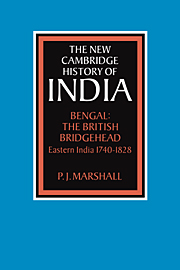Book contents
- Frontmatter
- 1 The setting for empire
- 2 Late Mughal Bengal
- 3 The crisis of empire, 1740–65
- 4 The new regime
- 5 A new society?
- 6 Conclusion
- Bibliographical Essay
- Index
- THE CAMBRIDGE HISTORY OF INDIA
- Map 1 Eastern India, 1740–1828: places mentioned in the text
- Map 2 Eastern India, 1740–1828: economic
- Plate Section">
- References
4 - The new regime
Published online by Cambridge University Press: 28 March 2008
- Frontmatter
- 1 The setting for empire
- 2 Late Mughal Bengal
- 3 The crisis of empire, 1740–65
- 4 The new regime
- 5 A new society?
- 6 Conclusion
- Bibliographical Essay
- Index
- THE CAMBRIDGE HISTORY OF INDIA
- Map 1 Eastern India, 1740–1828: places mentioned in the text
- Map 2 Eastern India, 1740–1828: economic
- Plate Section">
- References
Summary
In retrospect the year 1765, when the East India Company became the Emperor's Diwan, has come to be seen as the dividing line between Mughal and British Bengal. The establishment of British predominance in eastern India was, however, a gradual and protracted process, beginning before 1757, let alone 1765, and taking a considerable time to become fully effective throughout Bengal and Bihar. Subjugation of Orissa did not begin until the expulsion of the Marathas in 1803.
In theory the settlement of 1765 had not established a British Bengal. It had been no more than a reversion to an earlier division of power characteristic of Mughal provincial government. The Nazim and the Diwan were again to be separate offices held by separate people, as they had been before the rise of Murshid Kuli Khan. The Nawabs would still be Nazims, holding court at Murshidabad, from where they would direct the defence of the provinces and the ordering of their internal peace and justice. The East India Company, through its Governor and Council at Calcutta, would be Diwans, collecting revenue. Any implication that the two powers were effectively separate was, however, totally without substance after 1765. Events since 1757 had deprived the Nawabs of any capacity to take independent military or political action. The independence of the Nizamat was a fiction preserved by the Company for its own convenience, as in its dealings with other Europeans.
Keywords
- Type
- Chapter
- Information
- Bengal: The British BridgeheadEastern India 1740–1828, pp. 93 - 136Publisher: Cambridge University PressPrint publication year: 1988



